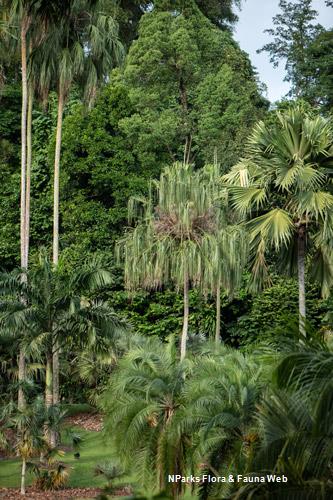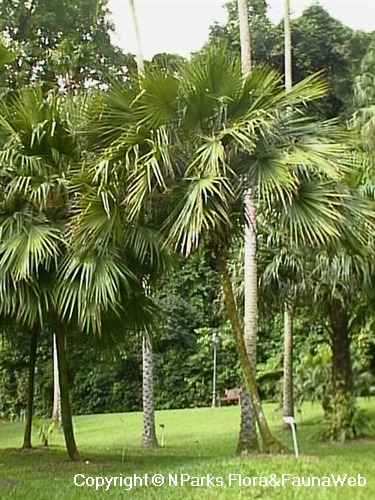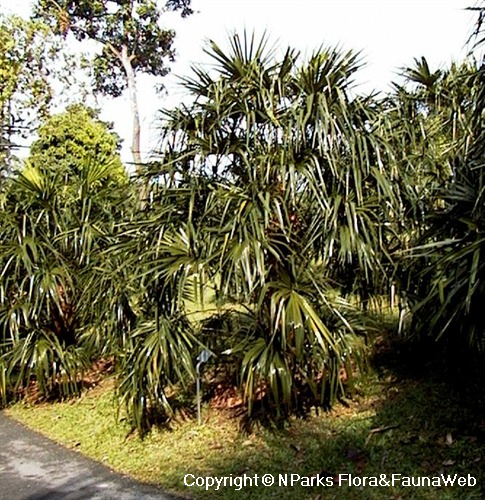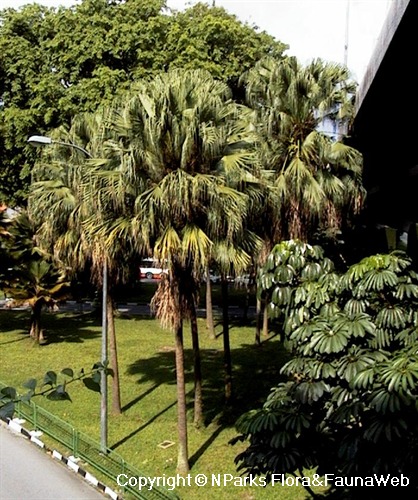
Back
Livistona decora (W.Bull) Dowe
| Family Name: | Arecaceae (Palmae) |
| Synonyms: | Corypha decora W.Bull, Livistona decipiens Becc., Livistona decipiens var. polyantha Becc. Livistona enervis Anon. |
| Common Name: | Weeping Cabbage Palm, Ribbon Fan Palm, Cabbage Palm |
Livistona decora , also known as Weeping Cabbage Palm, is a solitary palm that can reach up to 18 m tall. The petiole stubs frequently persist on the base of the stem even after the leaves fall off. It is a host plant for Yellow palm-dart and Orange palm-dart butterflies.
Name
Classifications and Characteristics
| Plant Division | Angiosperms (Flowering Seed Plants) |
|---|---|
| Plant Growth Form | Palm |
| Lifespan (in Singapore) | Perennial |
| Mode of Nutrition | Autotrophic |
| Plant Shape | Fountain (Palm-like) |
| Maximum Height | 18 m |
Biogeography
| Native Distribution | Australia |
|---|---|
| Native Habitat | Terrestrial (Coastal Forest, Riverine) |
| Preferred Climate Zone | Tropical, Sub-Tropical / Monsoonal |
| Local Conservation Status | Non-native |
Description and Ethnobotany
| Growth Form | It is a palm that can reach up to 18 m tall and has a solitary growth habit. Petiole stubs remain on the stem even after the leaves fall off. These stubs frequently persistent on the base of the stem. The stem is ringed with narrow leaf scars. |
|---|---|
| Foliage | Leaves are fan-shaped (costapalmate), about 1.2 – 1.85 m long, and deeply divided for 82 – 88% of the length. Leaves are regularly segmented and can have 70 – 84 segments each. The tip of the segment is pendulous. The petiole can reach up to 2.8 m long and is armed with curved black spines (about 1 cm long) along the margin. Coarse fibers are present at the base of the petiole. |
| Flowers | Inflorescence occurs between the leaves (interfoliar) and can reach 1 – 3.5 m long. It comprises of many small yellow flowers. Flower is funnel-shaped (1.5 – 2 mm long) with fleshy petals and membranous sepals. |
| Fruit | Fruit is round (about 1.2 – 1.4 cm diameter) with scattered lenticellular pores and suture line. It turns shiny black when mature. Each fruit contains 1 seed within. |
| Habitat | It is found in coastal forest or near coastal areas, up to 550 m altitude. |
| Similar | L. decora looks similar to L. australis except that L. decora has deeply segmented leaves and pendulous segment tips. |
| Associated Fauna | Flowers are pollinated by insects. It is also a host plant for Yellow palm-dart and Orange palm-dart butterflies. |
| Cultivation | It can be propagated by seed. |
| Ethnobotanical Uses | Others: The aborigines of Australia are reported to consume the young growing tip pf the palm raw or roasted. The leaves are used to make baskets, ornamental bracelets and neckbands. |
Landscaping Features
| Landscaping | It is drought tolerant when established but does not tolerate waterlogged condition. |
|---|---|
| Desirable Plant Features | Ornamental Foliage |
| Landscape Uses | General, Suitable for Roadsides |
| Usage Hazard - Cons | Spines/Thorns - Leaf |
| Usage Hazard - Cons Remarks | Petioles are armed with short spines. |
| Plant & Rootzone Preference or Tolerance Remarks | It does not tolerate waterlogged soils. |
Fauna, Pollination and Dispersal
| Fauna Pollination Dispersal Associated Fauna | Butterfly Host Plant |
|---|---|
| Pollination Method(s) | Biotic (Fauna) |
Plant Care and Propagation
| Light Preference | Full Sun |
|---|---|
| Water Preference | Moderate Water |
| Plant Growth Rate | Moderate |
| Rootzone Tolerance | Fertile Loamy Soils, Well-Drained Soils, Drought Tolerant |
| Maintenance Requirements | Moderate |
| Propagation Method | Seed |
Foliar
| Foliage Retention | Evergreen |
|---|---|
| Mature Foliage Colour(s) | Green |
| Mature Foliage Texture(s) | Smooth, Glossy / Shiny |
| Foliar Type | Simple / Unifoliate |
| Foliar Shape(s) | Palm Fronds (Fan / Costapalmate) |
| Typical Foliar Area | Megaphyll (>1640.25cm2 ) |
| Leaf Area Index (LAI) for Green Plot Ratio | 2.5 (Palm - Solitary) |
Non - Foliar and Storage
| Trunk Type (Non Palm) | Non Woody |
|---|---|
| Trunk Type (Palm) | Solitary Habit, Aboveground |
| Root Type | Underground (Fibrous Root) |
Floral (Angiosperm)
| Flower Colour(s) | Yellow / Golden |
|---|---|
| Flowering Habit | Polycarpic |
Fruit, Seed and Spore
| Mature Fruit Colour(s) | Black |
|---|---|
| Fruit Classification | Simple Fruit |
| Fruit Type | Fleshy Fruit |
References
| References | Anderson, E. (2016). Plants of Central Queensland: Identification and Uses of Native and Introduced Species, pp. 1–580. Victoria: CSIRO Publishing Dowe, J.L. (2009). A taxonomic account of Livistona R.Br. (Arecaceae). Gardens' Bulletin Singapore 60: 185-344. |
|---|
Image Repository
Others
| Master ID | 1357 |
|---|---|
| Species ID | 2650 |
| Flora Disclaimer | The information in this website has been compiled from reliable sources, such as reference works on medicinal plants. It is not a substitute for medical advice or treatment and NParks does not purport to provide any medical advice. Readers should always consult his/her physician before using or consuming a plant for medicinal purposes. |

_lowres.jpg)
_lowres.jpg)


